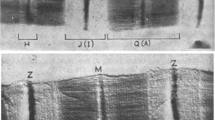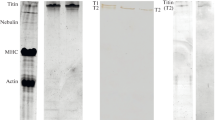Summary
Monospecific polyclonal antibodies against two exceptionally large proteins, titin (a-T) and nebulin (a-N) isolated from rabbit skeletal muscles, were raised in guinea pig. Using an immuno-pre-embedding method, we have localized at the ultrastructural level of resolution the reactivity sites in skinned muscle fibres. At resting length a-T and a-N antibodies recognize epitopes which only partially overlap. a-T antibodies decorate mostly the A band with at least four clearly distinguished lines of reaction and one line in the I band, all near the A/I limit; a-N antibodies bind to the same region, but with wider areas of reaction in both A and I bands. To study whether the localization of these reaction sites varies according to the sarcomere length, skinned rabbit psoas fibres were incubated at sarcomere lengths ranging from maximum shortening to overstretching. The results indicate that lines decorated by a-T move away from the Z disc when the sarcomere is lengthened. With respect to the M line, the behaviour was biphasic. When the sarcomere was stretched up to about 2.8 μm, the decorated lines maintain almost the same distance from the M line. When the sarcomere is stretched beyond 2.8 μm, all a-T epitopes move away from the M line and the molecule behaves elastically. At resting length the a-N decoration appears to be localized on three large adjacent bands at the I, A/I and A level. The a-N line of reaction at the edge of the A band moves away from the Z discs as the sarcomere lengthens, while a second line which seems to be localized at the tip of the thin filament moves away from M line when the sarcomere lengthens. In non-overlapping sarcomeres a-N antibodies decorate only the tip of the thin filaments. Our results indicate that titin forms a polar filament connecting the M line to the Z line. In short sarcomeres, the filament seems to have some connections with structures of the A band, since titin epitopes do not move during stretching. These connections are lost at longer sarcomere lengths. On the other hand, our results suggest that nebulin is probably not a constituent of the titin filament.
Similar content being viewed by others
References
Bonilla, E., Miranda, A., Prelle, A., Salviati, G., Betto, R., Zeviani, M., Schon, E. A., Dimauro, S. &Rowland, L. P. (1988) Immunocytochemical study of nebulin in Duchenne muscular dystrophy.Neurology 38, 1600–3.
Eastwood, A. B., Wood, D. S., Bock, K. L. &Sorenson, M. M. (1979) Chemically skinned mammalian skeletal muscle. I. The nature of skinned rabbit psoas.Tissue & Cell 11, 553–66.
Fürst, D. O., Osborn, M., Nave, R. &Weber, K. (1988) The organization of titin filaments in the halfsarcomere revealed by monoclonal antibodies in immunoelectron microscopy: a map of ten nonrepetitive epitopes starting at the Z line extends close to the M line.J. Cell Biol. 106, 1563–72.
Garamvolgyi, N. (1965) Inter Z-bridges in the flight muscle of the bee.J. Ultrastruct. Res. 13, 435–43.
Granger, B.L. &Lazarides, E. (1978) The existence of an insoluble Z-disc scaffold in chicken skeletal muscle.Cell 15, 1253–68.
Higuchi, H. &Umazume, Y. (1985) Localization of elastic component in frog muscle.Biophys. J. 48, 137–47.
Horowitz, R. &Podolsky, R. J. (1987) The positional stability of thick filaments in activated skeletal muscle depends on sarcomere length: evidence for the role of titin filaments.J. Cell Biol. 105, 2217–23.
Itoh, Y., Suzuki, T., Kimura, S., Ohashi, K., Higuchi, H., Sawada, H., Shimizu, T., Shibata, M. &Maruyama, K. (1988) Extensible and less extensible domains of connectin filaments in stretched vertebrate skeletal muscle sarcomeres as detected by immunofluorescence and immunoelectron microscopy using monoclonal antibodies.J. Biochem. (Tokyo) 104, 504–8.
Leary, J. J., Brigati, D. J. &Ward, D. C. (1983) Rapid and sensitive method for visualizing biotin-labelled DNA probes hybridized to DNA or RNA immobilized on nitrocellulose. Bio-blots.Proc. natn. Acad. Sci. U.S.A. 80, 4045–9.
Locker, R. H. &Leet, N. G. (1976) Histology of highly-stretched beef muscle. II. Further evidence on the localization and nature of gap filaments.J. Ultrastruct. Res. 55, 157–67.
Maruyama, K. (1986) Connectin, an elastic filamentous protein of striated muscle.Int. Rev. Cytol. 104, 81–114.
Maruyama, K., Matsubara, S., Nonomura, Y., Kimura, S., Ohashi, K., Murakami, F., Handa, S. &Eguchi, G. (1977) Connectin, an elastic protein of muscle: characterization and function.J. Biochem.(Tokyo) 82, 317–37.
Maruyama, K., Yoshioka, T., Higuchi, H., Ohashi, K., Kimura, S. &Natori, R. (1985) Connectin filaments link thick filaments and Z lines in frog skeletal muscle as revealed by immunoelectron microscopy.J. Cell Biol. 101, 2167–75.
Mould, A. P., Holmes, D. P., Kadler, K. E. &Chapman, J. A. (1985) Mica sandwich technique for preparing macromolecules for rotary shadowing.J. Ultrastruct. Res. 91, 66–76.
Natori, R. (1954) The property and contraction process of isolated myofibrils.Jikeikai Med. J. 1, 119–26.
Page, S. &Huxley, H. E. (1963) Filament length in striated muscle.J. Cell Biol. 19, 369–91.
Pierobon-Bormioli, S. (1980) Transverse sarcomere filamentous systems: ‘Z-,M’- and N′-cables.J. Musc. Res. Cell Motility 1, 445 (abstr.).
Pierobon-Bormioli, S. (1981) Transverse sarcomere filamentous systems: ‘Z- and M’-cables.J. Musc. Res. Cell Motility 2, 401–13.
Pierobon-Bormioli, S. (1985) Striated muscle cytohistoskeleton. In proceedings of Cell Biology and Clinical Management in Functional Electrostimulation of Neurones and Muscles (edited byCarraro, U. &Angelini, C.) pp. 57–9. Padova: Cleup.
Pierobon-Bormioli, S. (1988) Striated muscle structure function. The transverse histo-cytoskeleton. The endoskeleton. In Associazione di Biologia Cellulare e del Differenziamento (ABCD) VII Congresso Nazionale Spoleto 16–19 ottobre, pp. B11.Eur. J. Cell Biol. (in press) (abstr.).
Pierobon-Bormioli, S., Salviati, G. &Betto, R. (1988) Skeletal muscle. Endosarcomeric immunoultrastructure localization of titin/connectin, nebulin and ‘Band 4’. InSarcomeric and Non-Sarcomeric Muscles: Basic and Applied Research Prospects for the 90s (edited by)Carraro, U., pp. 501–6. Padova: Unipress.
Somerville, L. L. &Wang, K. (1988) Sarcomere matrix of striated muscle:in vivo phosphorylation of titin and nebulin in mouse diaphragm muscle.Arch. Biochem. Biophys. 262, 118–29.
Towbin, H., Staehelin, T. &Gordon, J. (1979) Electrophoretic transfer of proteins from polyacrylamide gels to nitrocellulosa sheets: procedures and some applications.Proc. natn. Acad. Sci. U.S.A. 76, 4350–4.
Tokuyasu, K. T., Dutton, A. H. &Singer, S. J. (1983) Immunoelectron microscopic studies of desmin (skeletin) localization and intermediate filament organization in chicken skeletal muscle.J. Cell Biol. 96, 1727–35.
Trinick, J., Knight, P. &Whiting, A. (1984) Purification and properties of native titin.J. molec. Biol. 180, 331–56.
Wang, K. (1981) Nebulin, a giant protein component of N2 line of striated muscle.J. Cell Biol. 91, 355a (abstr.).
Wang, K. (1982) Purification of titin and nebulin.Meth. Enzymol. 85b, 264–74.
Wang, K. (1984) Cytoskeletal matrix in striated muscle: the role of titin, nebulin and intermediate filaments. InContractile Mechanisms in Muscle (edited bySugi, H. &Pollack, C. H.), pp. 285–306. New York: Plenum Publishing Corp.
Wang, K. (1985) Sarcomere-associated cytoskeletal lattices in striated muscle. InCell and Muscle Motility (edited byShay, J. W.), pp. 315–69. New York: Plenum Press.
Wang, K., McLure, J. &Tu, A. (1979) Titin: major myofibrillar components of striated muscle.Proc. natn. Acad. Sci. U.S.A. 76, 3698–702.
Wang, K. &Williamson, C. L. (1980) Identification of an N2 line protein of striated muscle.Proc. natn. Acad. Sci. U.S.A. 77, 3254–8.
Wang, K. &Wright, J. (1987a) Architecture of sarcomere matrix in skeletal muscle. Evidence that nebulin constitutes a distinct set of non-extensible filaments in parallel with titin filaments.J. Cell Biol. 105, n4 part 2 n. 138, (abstr.).
Wang, K. &Wright, J. (1987b) Architecture of sarcomere matrix in skeletal muscle. Nebulin filament as a thin filament scaffold.Biophys. J. 5, 219a (abstr.).
Wang, K. &Wright, J. (1988a) Sarcomere matrix of skeletal muscle: the role of thick filaments in the segmental extensibility of elastic titin filaments.Biophys. J. 53, 25a (abstr.).
Wang, K. &Wright, J. (1988b) Architecture of the sarcomere matrix of skeletal muscle: immunoelectron microscopic evidence that suggests a set of parallel inextensible nebulin filaments anchored at the Z line.J. Cell Biol. 107, 2199–212.
Watkins, S. C., Samuel, J. L., Marotte, F., Bertier-Savalle, B. &Rappaport, L. (1987) Microtubules and desmin filaments during onset of heart hypertrophy in rat: a double immunoelectron microscope study.Circ. Res. 60, 327–36.
Wood, D. S., Zeviani, M., Prelle, A., Bonilla, E., Miranda, A. F., DiMauro, S. &Rowland, L. P. (1987) Is nebulin the defective gene product in Duchenne muscular dystrophy?N. Engl. J. Med. 316, 107–8.
Wood, D. S., Zollman, J. &Reuben, J. P. (1978) Human skeletal muscle. Properties of the ‘chemically skinned’ fibres.Science 187, 1075–6.
Zeviani, M., Darras, B. T., Rizzuto, R., Salviati, G., Betto, R., Miranda, E., Du, A. F., Samitt, C., Dickson, G., Walsh, F. S., Dimauro, S., Francke, U. &Schon, E. A. (1988) Cloning and expression of human nebulin cDNAs and assignment of the gene to chromosome 2q31-q32.Genomics 2, 249–56.
Author information
Authors and Affiliations
Rights and permissions
About this article
Cite this article
Pierobon-Bormioli, S., Betto, R. & Salviati, G. The organization of titin (connectin) and nebulin in the sarcomeres: an immunocytolocalization study. J Muscle Res Cell Motil 10, 446–456 (1989). https://doi.org/10.1007/BF01771820
Received:
Issue Date:
DOI: https://doi.org/10.1007/BF01771820




